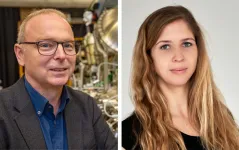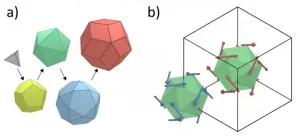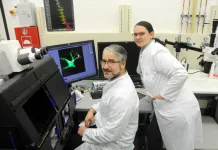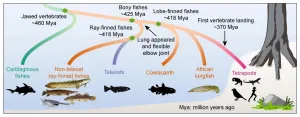SARS-CoV-2 under the helium ion microscope for the first time
Bielefeld researchers provide 3D images of coronaviruses
2021-02-04
(Press-News.org) Scientists at Bielefeld University's Faculty of Physics have succeeded for the first time in imaging the SARS-CoV-2 coronavirus with a helium ion microscope. In contrast to the more conventional electron microscopy, the samples do not need a thin metal coating in helium ion microscopy. This allows interactions between the coronaviruses and their host cell to be observed particularly clearly. The scientists have published their findings, obtained in collaboration with researchers from Bielefeld University's Medical School OWL and Justus Liebig University Giessen, in the Beilstein Journal of Nanotechnology.
'The study shows that the helium ion microscope is suitable for imaging coronaviruses - so precisely that the interaction between virus and host cell can be observed,' says physicist Dr Natalie Frese. She is the lead author of the study and a researcher in the research group Physics of Supramolecular Systems and Surfaces at the Faculty of Physics.
Coronaviruses are tiny - only about 100 nanometres in diameter, or 100 billionths of a metre. So far, mainly scanning electron microscopy (SEM) has been used to examine cells infected with the virus. With SEM, an electron beam scans the cell and provides an image of the surface structure of the cell occupied by viruses. However, SEM has a disadvantage: the sample becomes electrostatically charged during the microscopy process. Because the charges are not dispersed from non-conductive samples, for example viruses or other biological organisms, the samples must be coated with an electrically conductive coating, such as a thin layer of gold.
'However, this conductive coating also changes the surface structure of the sample. Helium ion microscopy does not require a coating and therefore allows direct scanning,' says Professor Dr Armin Gölzhäuser, who heads the research group Physics of Supramolecular Systems and Surfaces. With the helium ion microscope, a beam of helium ions scans the surface of the sample. Helium ions are helium atoms that are each missing an electron - they are therefore positively charged. The ion beam also charges the sample electrostatically, but this can be compensated for by additionally irradiating the sample with electrons.
Furthermore, the helium ion microscope has a higher resolution and a greater depth of field.
In their study, the scientists infected cells - artificially produced from the kidney tissue of a species of monkey - with SARS-CoV-2 and studied them in dead state under the microscope. 'Our images provide a direct view of the 3D surface of the coronavirus and the kidney cell - with a resolution in the range of a few nanometres,' says Frese. This enabled the researchers to visualise interactions between the viruses and the kidney cell. Their study results indicate, for example, that helium ion microscopy can be used to observe whether individual coronaviruses are just lying on the cell or are bound to it. This is important in order to understand defence strategies against the virus: an infected cell can bind the viruses, which have already multiplied inside it, to its cell membrane on exit and thus prevent them from spreading further.
'Helium ion microscopy is well suited for imaging the cell's defence mechanisms that take place at the cell membrane,' says virologist Professor Dr Friedemann Weber, too. He is investigating SARS-CoV-2 at Justus Liebig University in Gießen and collaborated with the Bielefeld researchers on this study. Professor Dr Holger Sudhoff, head physician at the University Clinic for Otolaryngology, Head and Neck Surgery, Medical School OWL at Bielefeld University, adds: 'This method is a significant improvement for imaging the SARS-CoV-2 virus interacting with the infected cell. Helium ion microscopy can help to better understand the infection process in COVID-19 sufferers.'
Helium ion microscopy is a comparatively new technology. In 2010, Bielefeld University became the first German university to acquire a helium ion microscope, which is used primarily in nanotechnology. Worldwide, helium ion technology is still rarely used to examine biological samples. 'Our study shows that there is great potential here,' says Gölzhäuser. The study appears in a special issue of the Beilstein Journal of Nanotechnology on the helium ion microscope.
INFORMATION:
Original publication:
Natalie Frese, Patrick Schmerer, Martin Wortmann, Matthias Schürmann, Matthias König, Michael Westphal, Friedemann Weber, Holger Sudhoff, Armin Gölzhäuser: Imaging of SARS-CoV-2 infected Vero E6 cells by helium ion microscopy. Beilstein Journal of Nanotechnology, https://www.doi.org/10.3762/bjnano.12.13, published on 2 February 2021.
[Attachments] See images for this press release:

ELSE PRESS RELEASES FROM THIS DATE:
2021-02-04
People undergoing long-term dialysis are almost 4 times more likely to die from COVID-19 and should be prioritized for vaccination, found a new Ontario study published in CMAJ (Canadian Medical Association Journal).
"As the COVID-19 pandemic proceeds, focused efforts should be made to protect this population from infection including prioritizing patients on long-term dialysis and the staff treating them for SARS-CoV-2 vaccination," writes Dr. Peter Blake, provincial director, Ontario Renal Network, Ontario Health, and professor, Schulich School of Medicine and Dentistry, Western University, ...
2021-02-04
It is necessary to develop additional COVID-19 vaccines, as different vaccine approaches have their advantages and disadvantages and may work synergistically. Researchers at Karolinska Institutet in Sweden now report that they have developed a prototype vaccine against SARS-CoV-2 using a DNA vaccine platform that is inexpensive, stable, easy to produce, and shows a good safety profile. A study published in Scientific Reports shows that the vaccine induces potent immune responses in mice.
The vaccine, called DREP-S, is administered as DNA and is based on a DNA-launched self-amplifying RNA (DREP) platform developed at Karolinska ...
2021-02-04
Between chemistry classes, gemstones, and electronics, the idea of crystals, substances with an ordered and periodic arrangement of atoms is quite common. But about 40 years ago, a strange particle was discovered by scientists that hasn't become commonplace in our world yet: quasicrystals. These are structures with curious atomic arrangements, which, while superficially similar to crystals, lack periodicity despite being ordered. Because of their structures, quasicrystals exhibit symmetries forbidden to crystals and are endowed with interesting properties that crystals cannot show, ...
2021-02-04
The unmet HIV prevention and treatment needs of female sex workers and especially their male clients could contribute substantially to ongoing HIV transmission in South Africa, according to a new study led by researchers at the University of Bristol, UK.
The researchers used mathematical modelling to look at the contribution of commercial sex, sex between men, and other heterosexual partnerships to HIV transmission in South Africa.
They found that, over a ten-year period (2010-19), sex between female sex workers and their paying clients contributed 6.9 per cent of new HIV infections, while ...
2021-02-04
In order to fight pathogens, mast cells regulate inflammatory reactions of the immune system. Both mast cells and neutrophils are white blood cells and are critical for the body's immune defense. A team of scientists around the immunologist Prof. Dr. Anne Dudeck and the bioengineer Jan Dudeck has discovered a crucial aspect of the communication between mast cells and neutrophils. These new findings may allow for developing innovative, targeted therapeutic strategies to dampen allergic responses and inflammatory reactions. The results have been published ...
2021-02-04
ADELPHI, Md. -- A new quantum sensor can analyze the full spectrum of radio frequency and real-world signals, unleashing new potentials for soldier communications, spectrum awareness and electronic warfare.
Army researchers built the quantum sensor, which can sample the radio-frequency spectrum--from zero frequency up to 20 GHz--and detect AM and FM radio, Bluetooth, Wi-Fi and other communication signals.
The Rydberg sensor uses laser beams to create highly-excited Rydberg atoms directly above a microwave circuit, to boost and hone in on the portion of the spectrum being measured. The Rydberg atoms are sensitive to the circuit's voltage, enabling the device to be used as a sensitive probe for the wide range of signals in the RF spectrum.
"All ...
2021-02-04
People traditionally think that lungs and limbs are key innovations that came with the vertebrate transition from water to land. But in fact, the genetic basis of air-breathing and limb movement was already established in our fish ancestor 50 million years earlier. This, according to a recent genome mapping of primitive fish conducted by the University of Copenhagen, among others. The new study changes our understanding of a key milestone in our own evolutionary history.
There is nothing new about humans and all other vertebrates having evolved from fish. The conventional understanding has been that certain fish shimmied landwards roughly ...
2021-02-04
A global team of researchers has developed a new strategy for fast and reliable antibody tests, which can quantify the immune response induced by vaccination and reveal the timeline and stage of pathogen infection.
Led by Professor Martin Hegner, Principal Investigator in CRANN and Trinity College Dublin's School of Physics, the team's one-step quantitative antibody tests are conducted using (blood) serum and are on a par with the gold-standard, enzyme-linked immunosorbent assay (ELISA) technique.
The major advantage of the newly developed nano technique with respect to ELISA tests is that it is equally ...
2021-02-04
ATLANTA - Researchers at Yerkes National Primate Research Center, Emory University, have developed a COVID-19 vaccine that has proven safe and effective in mice and monkeys. Results from this National Institute of Allergy and Infectious Diseases (NIAID)-funded study are published online today in Immunity.
The Emory MVA COVID-19 vaccine approaches inducing protective immunity via modified vaccinia Ankara (MVA), a harmless version of a poxvirus that is well-known for its use in HIV/AIDS vaccines. Like the Moderna and Pfizer COVID-19 vaccines, the Emory MVA COVID-19 vaccine ...
2021-02-04
New research carried out by City, University of London data scientist, Dr Andrea Baronchelli, and colleagues into the dark web marketplace (DWM) trade in products related to COVID-19, has revealed the need for the continuous monitoring of dark web marketplaces (DWMs) especially in light of the current shortage and availability of coronavirus vaccines.
In their paper, Dark Web Marketplaces and COVID-19: before the vaccine published in the EPJ Data Science, Dr Baronchelli and his colleagues analysed 851,199 listings extracted from 30 DWMs between January 1, 2020 and November 16, 2020 before the advent of the availability of the coronavirus vaccine.
They identify 788 listings directly related to COVID-19 ...
LAST 30 PRESS RELEASES:
[Press-News.org] SARS-CoV-2 under the helium ion microscope for the first time
Bielefeld researchers provide 3D images of coronaviruses






